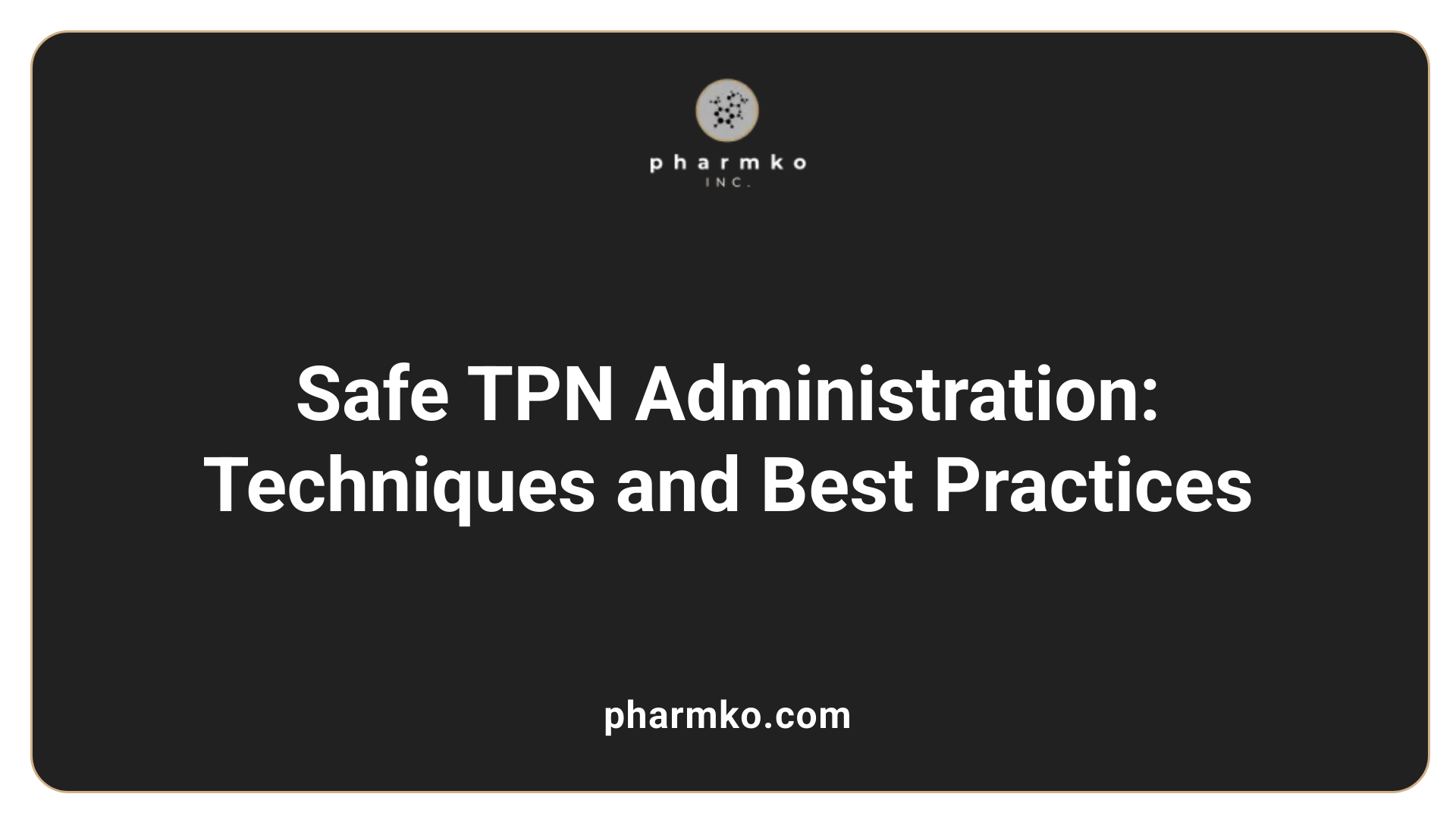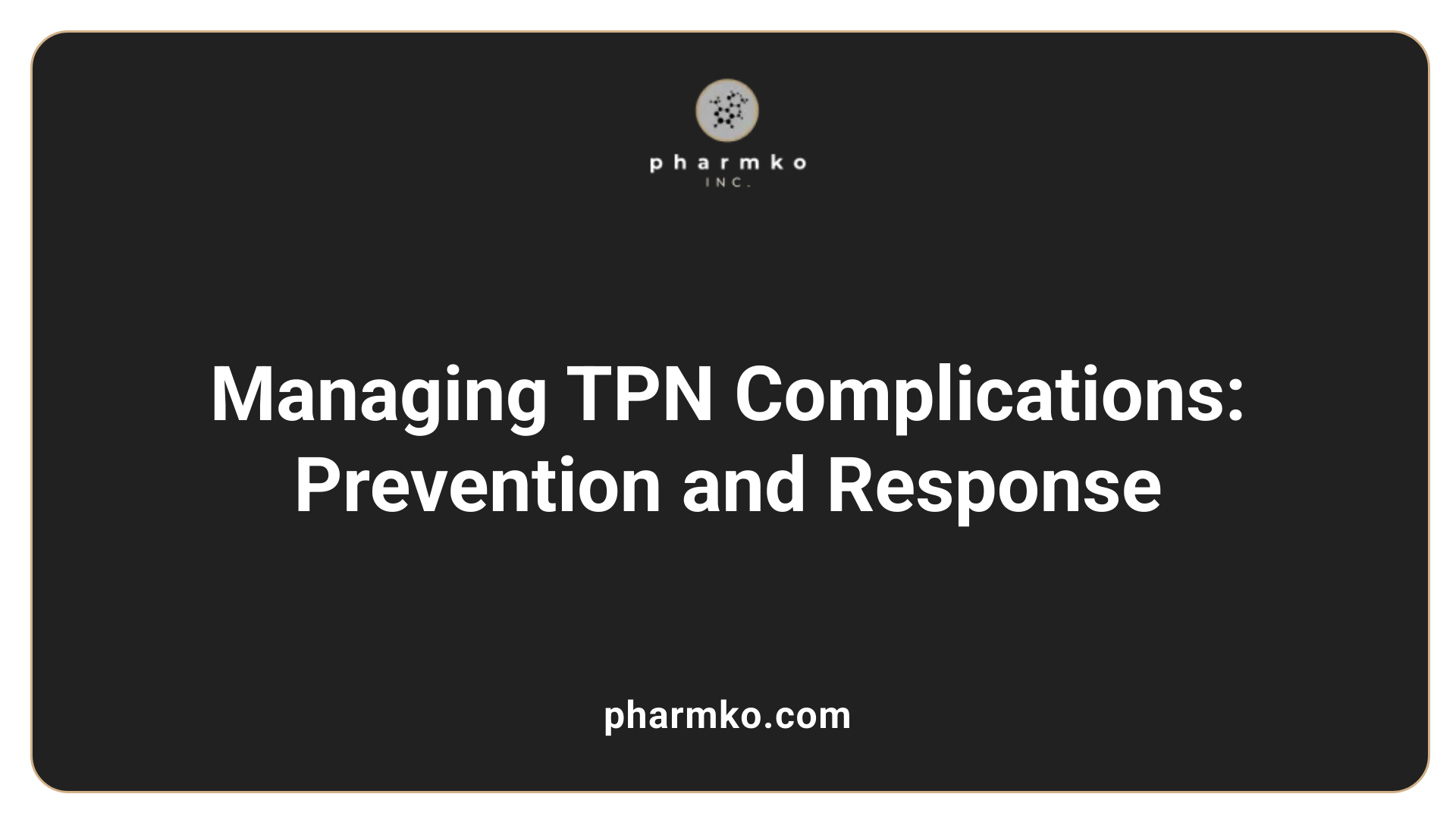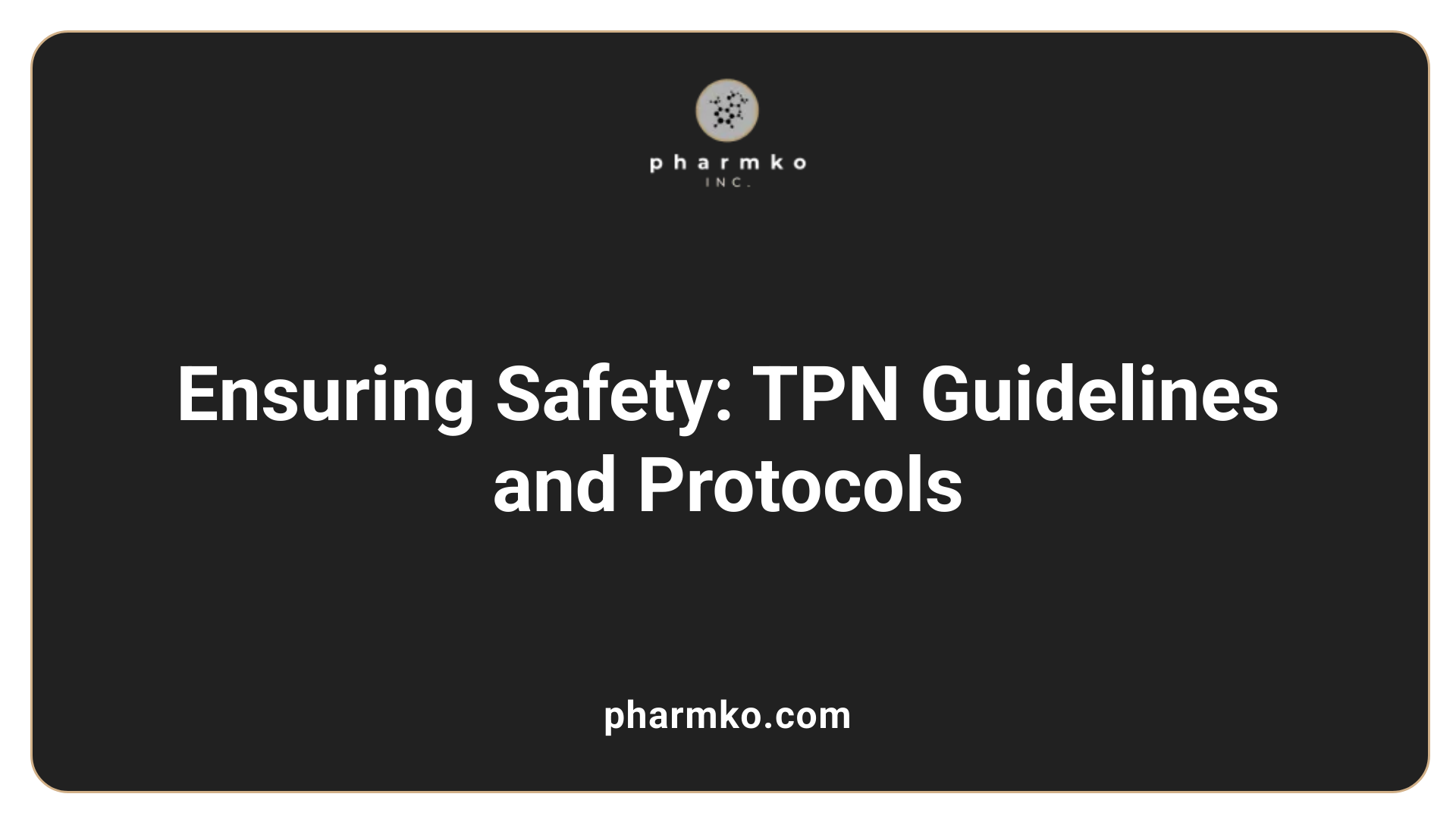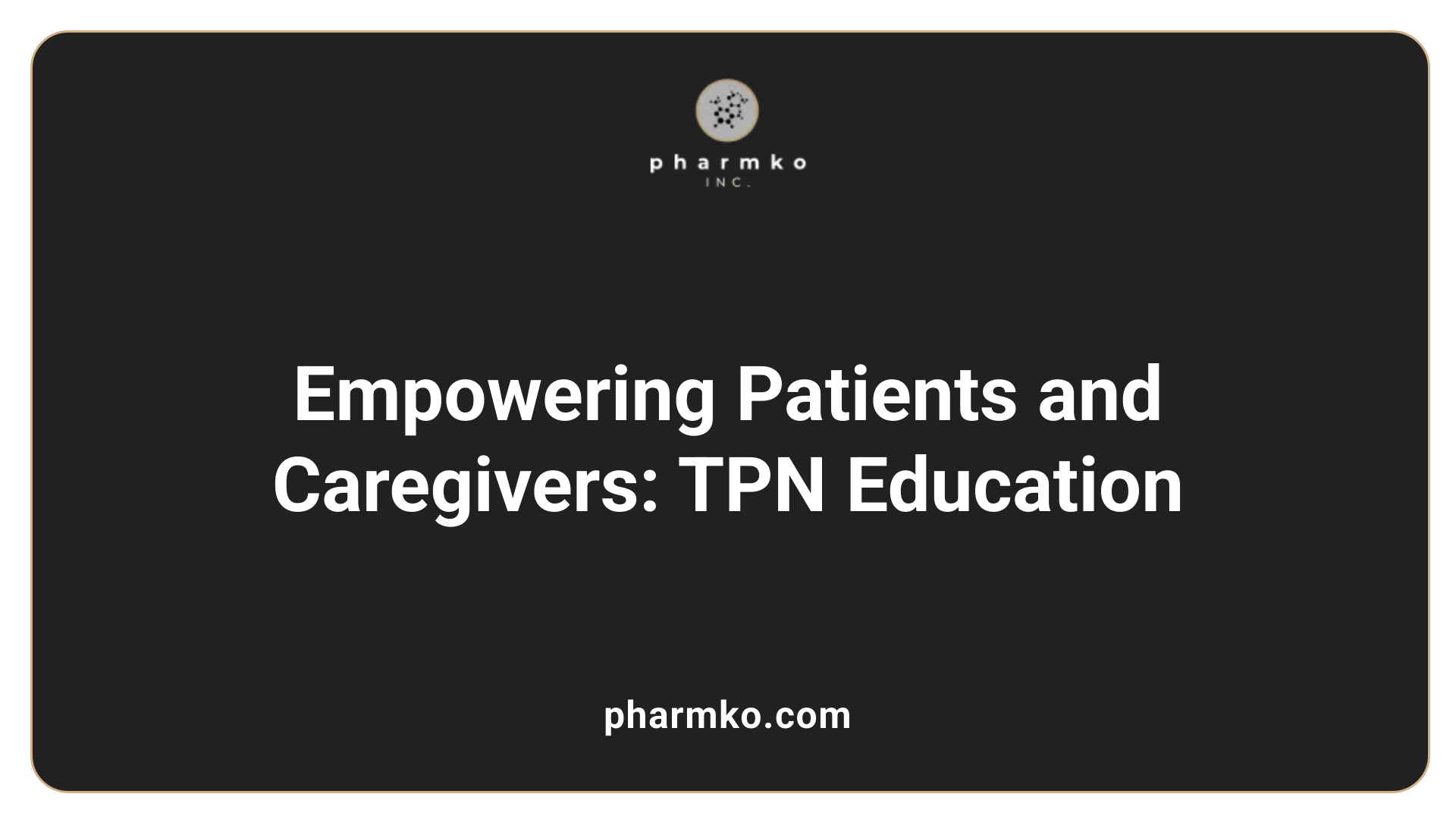Maintaining health on TPN nutrition
Understanding and Managing TPN for Better Health
Total parenteral nutrition (TPN) is a vital medical intervention for patients who cannot meet their nutritional needs through oral or enteral feeding. It involves delivering essential nutrients directly into the bloodstream via a central venous catheter, bypassing the gastrointestinal tract. Proper management, monitoring, and education are critical to maintaining health, preventing complications, and ensuring the therapy's effectiveness for those requiring long-term nutritional support.
What Is Total Parenteral Nutrition (TPN) and Why Is It Used?

What is total parenteral nutrition (TPN) and what are its indications, purpose, and benefits?
Total parenteral nutrition (TPN) is a specialized method of feeding that delivers nutrients directly into a large vein, bypassing the digestive system entirely. It is typically administered through a central venous catheter, allowing nutrients to quickly enter the bloodstream.
TPN is primarily used when the gastrointestinal (GI) tract cannot be used safely or effectively for food intake. Conditions such as bowel obstruction, severe malabsorption, intestinal failure, or certain post-surgical states may prevent normal eating or digestion.
The main goal of TPN is to prevent or treat malnutrition by providing all necessary nutrients—carbohydrates, proteins, fats, vitamins, minerals, electrolytes, and fluids—in a carefully formulated mixture tailored to individual patient needs.
Benefits of TPN include maintaining adequate nutritional status, promoting tissue repair and healing, supporting immune function, and improving overall clinical outcomes. It is a vital intervention for patients in critical or long-term conditions where oral or enteral feeding is impossible.
How TPN Is Administered and Managed Safely

Methods of administration
Total parenteral nutrition (TPN) is given directly into the bloodstream through a central venous catheter. This method allows rapid delivery of nutrients, bypassing the digestive system entirely. The infusion is typically carried out using an infusion pump that controls the flow rate to match the patient's specific needs. The duration of infusion is usually about 10 to 12 hours per day, often scheduled overnight to minimize interference with daily activities. For long-term support, cycling TPN during sleep has become common, providing flexibility and mobility for patients.
Types of venous access
The choice of venous access device is critical for safe TPN delivery. Common options include peripherally inserted central catheters (PICC lines), tunneled catheters like Hickman lines, and fully implanted ports. PICC lines are popular for intermediate-term use and can be inserted at the bedside. Tunneled catheters and ports are preferred for longer-term therapy due to lower infection risks. The catheter tip is usually positioned in the superior vena cava or right atrium, ensuring rapid dilution of the TPN solution and reducing irritation.
Handling and preparation techniques
Preparation of TPN involves meticulous aseptic technique to prevent infections. Prior to handling, healthcare professionals must wash hands thoroughly and disinfect all working surfaces with appropriate germicidal agents. The TPN bags are stored refrigerated at around 35°F and should be warmed to room temperature for 2 to 4 hours before use, avoiding microwaving to prevent uneven heating.
Adding supplements or medications to the TPN requires sterile procedures. Vials and ports are disinfected with alcohol pads for at least 15 seconds before connection. Any additives, such as insulin or vitamins, are mixed carefully, checked for cloudiness or particles, and then infused using sterile techniques. When attaching the infusion to the catheter, connections must be secure and free of air bubbles. During disconnection, catheters are flushed with saline using a push/pause technique to maintain patency.
Proper handling and preparation are vital to prevent contamination, reduce infection risk, and ensure that the patient receives accurate nutrition tailored to their needs. Ongoing staff education and strict adherence to sterile procedures form the cornerstone of safe TPN management.
Recognizing and Managing TPN-Related Complications

What are common complications of TPN, and how can they be prevented or managed?
Total Parenteral Nutrition (TPN) is a vital therapy for patients unable to feed through their gastrointestinal tract. However, it carries potential risks that require careful attention. Common problems include infections such as catheter-related bloodstream infections (CRBSIs). These infections can be minimized by strict aseptic technique during catheter placement, handling, and maintenance, including thorough hand hygiene, sterilizing access points, and regular site assessment.
Metabolic disturbances are also prevalent. Patients may experience hyperglycemia or hypoglycemia, electrolyte imbalances, and refeeding syndrome. Monitoring blood glucose levels frequently allows for timely adjustments to insulin or glucose infusion rates. Electrolyte panels are regularly checked to detect imbalances in sodium, potassium, magnesium, and calcium, which can be corrected promptly to prevent complications.
Venous and catheter-related issues like thrombosis, air embolism, bleeding, and venous injury are significant concerns with long-term TPN use. To prevent thrombosis, ensuring proper catheter placement and securement, along with periodic ultrasound checks, are recommended. Proper flushing protocols with saline help prevent occlusions and embolisms. In case of mechanical complications, immediate medical response is crucial.
Long-term TPN use might lead to liver problems, such as fatty liver or cholestasis, and micronutrient toxicities, notably manganese or iron overload. Regular liver function tests and careful formulation of TPN solutions can reduce these risks.
Managing these issues effectively includes early identification of symptoms like fever, chills, abdominal pain, or signs of catheter malfunction. Medical interventions may involve antibiotics for infections, electrolyte repletion, insulin therapy for blood sugar control, or potentially catheter removal and replacement if infected or obstructed.
Through dedicated multidisciplinary support involving clinicians, pharmacists, and dietitians, and by adhering to strict sterile procedures, healthcare providers can significantly reduce the incidence of TPN-related complications. Vigilant monitoring and prompt treatment are essential to maintaining patient safety and optimizing nutritional support.
For more comprehensive management strategies, you can search for "Managing complications of TPN effectively." This approach ensures that risks are minimized and patients receive safe, effective nutritional therapy.
Adhering to Guidelines and Safety Protocols

What guidelines and safety practices should be followed during TPN therapy?
During TPN therapy, healthcare providers must adhere strictly to safety standards to ensure patient safety and the effectiveness of the treatment. Proper formulation verification involves double-checking the components, including dextrose, amino acids, lipids, vitamins, minerals, and electrolytes, to match the patient's individualized plan.
Sterile technique is critical in all stages of TPN preparation and delivery. This includes thorough hand hygiene, disinfecting ports and vials with alcohol pads for at least 15 seconds, and preparing the solution in a clean, dedicated work area away from household traffic, to minimize the risk of infection.
The use of appropriate filters, such as 1.2-micron filters, helps prevent particulate contamination, particularly when lipid emulsions are added. TPN solutions should be stored in the refrigerator at 35°F (1.6°C) and warmed to room temperature before administration to maintain stability and prevent bacterial growth.
Monitoring is essential to detect and address potential complications early. Key parameters include tracking intake and output, serum electrolytes, blood glucose levels, as well as liver and renal function tests. Regular assessments help identify issues like hyperglycemia, hypoglycemia, electrolyte imbalances, and refeeding syndrome.
A multidisciplinary team, comprising physicians, pharmacists, dietitians, and nursing staff, plays a vital role in developing the individual nutrition plan, monitoring patient response, adjusting nutrient composition, and managing complications.
Photoprotection for TPN solutions and lipids is necessary to prevent oxidative damage, especially in sensitive populations like neonates. It involves shielding solutions from light exposure during storage and infusion.
Strategies for managing component shortages, such as substituting similar formulations carefully, and protocols for timely discontinuation when nutritional goals are achieved, ensure continuous, safe therapy.
Preventing infections such as catheter-related bloodstream infections (CLABSI) involves meticulous catheter site care, aseptic handling, and proper disinfection of all connection points during setup and administration.
Overall, strict adherence to these guidelines, combined with thorough staff training and ongoing patient monitoring, fosters safe TPN use, minimizes risks, and optimizes patient outcomes.
Educating Patients and Caregivers in TPN Management

How do healthcare providers educate patients and caregivers about TPN management?
Healthcare providers play a vital role in equipping patients and caregivers with the knowledge and skills necessary for safe TPN administration. Education begins with comprehensive sessions that explain the purpose of TPN, detailing its components, such as lipids, dextrose, amino acids, vitamins, minerals, and electrolytes.
A primary focus is on infection prevention. Patients and caregivers are instructed on sterile techniques for preparing and handling TPN, including hand hygiene, cleaning ports with alcohol pads, and maintaining a clean work environment away from household traffic.
Training includes step-by-step guidance on setting up the infusion pump, attaching it to the catheter, and managing the infusion schedule, whether continuous or cycling. Hands-on practice supervised by a trained home infusion nurse ensures confidence before independent management.
They are shown how to inspect TPN solutions for leaks, discoloration, or floating particles, and how to store the solutions correctly in the refrigerator, warming them to room temperature before use.
It is also essential that they learn to add medications or vitamins aseptically if prescribed, and to check the expiration dates and visual condition of the solutions.
Recognizing signs of complications is another critical component. Patients and caregivers are educated on symptoms such as redness, swelling, or pain at the catheter site, fever, chills, abnormal blood glucose levels, and signs of dehydration. Knowing when to seek medical attention can prevent serious adverse events.
Follow-up appointments and ongoing assessments by a multidisciplinary team, including physicians, pharmacists, and dietitians, provide continuous support and education adjustments tailored to individual needs. This comprehensive approach ensures safety, promotes adherence, and enhances overall care efficiency.
Lifestyle Adjustments for TPN Patients
What lifestyle considerations are important for patients on TPN, and how can they adjust to this therapy?
Patients on total parenteral nutrition (TPN) need to make several lifestyle adjustments to ensure safety, comfort, and better quality of life. Proper self-care is vital, especially in maintaining hygiene and preventing infections. Hand hygiene, including thorough handwashing before handling supplies or touching the catheter site, reduces the risk of bloodstream infections.
Training in self-administration techniques is essential. Patients should learn how to prepare TPN solutions correctly, operate infusion pumps safely, and perform aseptic techniques during setup and disconnection. These skills empower patients to manage their therapy confidently, whether at home or in healthcare facilities.
Adjusting infusion schedules can help accommodate daily routines. TPN is often infused overnight over 10 to 12 hours, which allows individuals to participate more fully in daytime activities. Some may use portable infusion pumps, facilitating mobility and even social interactions.
Consistent monitoring for side effects such as infection signs, metabolic disturbances, or catheter complications is critical. Regular check-ups and blood tests enable timely adjustments to the TPN formulation or infusion rate.
Support from healthcare teams, including nurses, dietitians, and pharmacists, alongside emotional support from friends, family, or support groups, significantly benefits patients. Addressing the emotional and psychological impacts of living with TPN helps maintain mental well-being.
Incorporating TPN into everyday life requires planning and organization. Keeping supplies neatly stored, adhering to hygiene protocols, and following medical advice ensures the therapy remains safe and effective.
By embracing these lifestyle modifications, TPN patients can lead active, fulfilling lives while managing their nutritional needs through this vital therapy.
Long-term Outlook and Nutritional Composition
Is TPN a lifelong therapy, and what is the expected life expectancy for patients on TPN?
For some patients, TPN may become a lifelong treatment, particularly when they have chronic intestinal failure and do not recover bowel function. The outlook varies significantly depending on individual health, underlying conditions, and complications.
Research indicates that survival rates for TPN-dependent individuals range from 65% to 80% at three years. However, longer-term survival beyond one year can be limited, especially if patients have additional health issues like malignancies.
Many patients requiring TPN are managed at home and may live several years with proper care. Their life expectancy is influenced by factors such as age, the presence of cancer, and other health conditions. For example, patients with incurable cancer who are on TPN might survive over a year with quality of life maintained for some time.
In some cases, if complications from TPN arise or the prognosis is poor, an intestinal transplant might be considered, providing a potential but complex avenue for extending life.
How are TPN solutions tailored to meet individual nutritional needs?
Each TPN solution is uniquely tailored for the patient, containing a mixture of carbohydrates, proteins, fats, electrolytes, vitamins, and minerals. The exact composition is customized based on current laboratory assessments, nutritional status, and specific medical conditions.
Formulations are adjusted to balance energy provision, correct deficiencies, and prevent excess intake that could cause toxicity. For instance, the amount of dextrose is set according to the patient’s glucose tolerance, while amino acids are provided at levels suitable for tissue repair and growth.
Electrolyte and mineral concentrations are tailored to match blood lab results, ensuring proper balance and avoiding imbalances that can lead to serious complications such as cardiac arrhythmias or bone demineralization.
Overall, TPN formulations are carefully designed to supply all necessary nutrients intravenously, supporting healing and maintaining health when oral or enteral nutrition is not feasible.
| Aspect | Customization Level | Purpose | Monitoring Needed |
|---|---|---|---|
| Macronutrients (Carbs, Proteins, Fats) | Fully personalized | Meet energy and tissue requirements | Blood glucose, lipid panel |
| Electrolytes and Minerals | Based on lab results | Maintain cellular function and fluid balance | Serum electrolyte levels |
| Vitamins & Trace Elements | Tailored to deficiency status | Support metabolic processes | Vitamin & mineral serum levels |
Careful adjustment of these components helps optimize patient health, minimize risks, and improve the overall outcomes of long-term TPN therapy.
Optimizing TPN for Safe and Effective Nutrition
Effective management of TPN involves a comprehensive understanding of its administration, vigilant monitoring for complications, and thorough patient and caregiver education. Maintaining strict aseptic techniques, adhering to safety protocols, and customizing nutrient formulations are essential steps in promoting safety and health in patients dependent on TPN. Regular follow-up, early detection of issues, and psychosocial support can significantly improve quality of life and outcomes, making TPN a lifeline for those with complex nutritional needs. With proper care and collaboration among healthcare professionals, patients can enjoy improved health, vitality, and well-being while on TPN therapy.
References
- Total Parenteral Nutrition - StatPearls - NCBI Bookshelf
- [PDF] Total Parenteral Nutrition: Home Care Guide - Northwestern Medicine
- Parenteral Nutrition: What it Is, Uses & Types - Cleveland Clinic
- Total parenteral nutrition: MedlinePlus Medical Encyclopedia
- Total Parenteral Nutrition (TPN): Care Instructions - MyHealth Alberta
- [PDF] Total Parenteral Nutrition: Home Care Guide - Northwestern Medicine
- Home Total Parenteral Nutrition (TPN)
- [PDF] Home total parenteral nutrition (TPN): Continuous TPN - IU Health
- A Guide to Home Parenteral Nutrition for New Patients
- Nutrition Support (Enteral and Parenteral)













